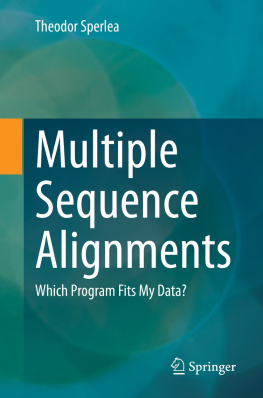Theodor Sperlea - Multiple Sequence Alignments : Which Program Fits My Data?
Here you can read online Theodor Sperlea - Multiple Sequence Alignments : Which Program Fits My Data? full text of the book (entire story) in english for free. Download pdf and epub, get meaning, cover and reviews about this ebook. publisher: Springer Berlin Heidelberg, genre: Children. Description of the work, (preface) as well as reviews are available. Best literature library LitArk.com created for fans of good reading and offers a wide selection of genres:
Romance novel
Science fiction
Adventure
Detective
Science
History
Home and family
Prose
Art
Politics
Computer
Non-fiction
Religion
Business
Children
Humor
Choose a favorite category and find really read worthwhile books. Enjoy immersion in the world of imagination, feel the emotions of the characters or learn something new for yourself, make an fascinating discovery.
- Book:Multiple Sequence Alignments : Which Program Fits My Data?
- Author:
- Publisher:Springer Berlin Heidelberg
- Genre:
- Rating:3 / 5
- Favourites:Add to favourites
- Your mark:
- 60
- 1
- 2
- 3
- 4
- 5
Multiple Sequence Alignments : Which Program Fits My Data?: summary, description and annotation
We offer to read an annotation, description, summary or preface (depends on what the author of the book "Multiple Sequence Alignments : Which Program Fits My Data?" wrote himself). If you haven't found the necessary information about the book — write in the comments, we will try to find it.
Multiple Sequence Alignments : Which Program Fits My Data? — read online for free the complete book (whole text) full work
Below is the text of the book, divided by pages. System saving the place of the last page read, allows you to conveniently read the book "Multiple Sequence Alignments : Which Program Fits My Data?" online for free, without having to search again every time where you left off. Put a bookmark, and you can go to the page where you finished reading at any time.
Font size:
Interval:
Bookmark:


This Springer imprint is published by the registered company Springer-Verlag GmbH, DE part of Springer Nature.
The registered company address is: Heidelberger Platz 3, 14197 Berlin, Germany
To my wife Johanna
Sometimes misunderstandings, mistakes, and frustration arise when doing research interdisciplinarily. Different disciplines speak different languages; as a result, when they talk about the same issue, they sometimes talk past each other. For different disciplines, the same word can mean different things, increasing the possibility of misunderstanding.
Bioinformatics is an interdisciplinary field par excellence. Here, experts in biology, computer science, medicine, pharmacy, chemistry, algorithmics, mathematics, and engineering come together to tackle scientific questions in collaboration. To make matters worse, bioinformatics is a fairly young field but has quickly gained enormous importance. Sequence analyses, modeling, and database searches have become an integral part of everyday biological and medical research. It is therefore all the more tragic when incorrect results are generated or interesting findings are overlooked due to incorrect use of these tools.
Some aspects of bioinformatics are almost predestined for such misunderstandings. Take multiple sequence alignments (MSAs): although this class of methods is commonly used for a wide range of biological questions, they are quite rarely explicitly discussed in the curricula of wet-lab biology students. The programs that compose these MSAs from single sequences often have an interdisciplinary history: the evolutionary biology questions they are supposed to answer were initially tackled by rather theory-heavy algorithmists. The resulting programs are black boxes for most of their users: magical objects that are used but not understood. Furthermore, every year new programs for generating MSAs are written that are more accurate or at least exciting on an algorithmic level. But for the most part, these developments miss their target audience, because as a biologist, you almost never go with the state of the art, because you use the MSA program you have always used and that has always done the job.
This book was written to help biologists to prevent misunderstandings when talking about or working with MSA programs. It is structured and written in such a way that it can explain to people with varying levels of prior knowledge how the programs that were written to produce MSAs work. The first part of this book deals with the background of MSAs: Chap..
The chapter structure of this book is thus designed to provide a layer-by-layer, ever-deepening introduction to the background and use of MSAs or MSA programs. This book is intended as a reference work in which the sections relevant to a given situation can be quickly identified. Some readers will be able to skip the descriptions of MSA formats because they are mainly interested in how a specific program works in detail. Nevertheless, I hope that the chapters are arranged in such a way that a generally interested person will find them an almost exciting read.
Finally, it remains for me to thank all the people without whom this book would not have been possible in this form. For the analysis in the back of the book, computations were performed on the MaRC2 high-performance computer at Philipps-Universitt Marburg. For the installation and maintenance of the programs used, I would like to thank Mr. Sitt of the Hessian Competence Center for High Performance Computing, funded by the Hessian Ministry of Science and Art. I would also like to thank Prof. Dr. Torsten Waldminghaus, Prof. Dr. Dominik Heider, and Carlo Klein, who encouraged me to tackle this project. I would like to thank Johanna Sperlea for her constant encouragement and proofreading. I would like to thank my project management contacts Stefanie Schmoll and Meike Barth for their constant support and great help with style and content. Special thanks go to Sarah Koch in her role as Publishing Editor at Springer, who gave me a great leap of faith when she offered me this book project and whose ideas were very helpful in finding the concept.
This book is about with programs that generate multiple sequence alignments (MSAs). This class of programs is probably the most widely used and diverse class of programs in bioinformatics. Over the past 30 years, countless programs and approaches have been developed to generate MSAs from protein and DNA sequences. These programs typically occupy the first chapters of relevant bioinformatics textbooks and the first few hours of most introductory lectures. Yet biologists spend quite little brainpower on the question of which of the many different programs is the optimal one for the problem before us at the moment; we just use the one tool we have always used. The book you are reading right now was written to change that. Step by step and in increasing detail, we will approach the MSA program phenomenon. Finally, Chap. contains the results of a large-scale comparative study that was conducted to answer the question of which MSA program is the optimal one for a given problem.
Font size:
Interval:
Bookmark:
Similar books «Multiple Sequence Alignments : Which Program Fits My Data?»
Look at similar books to Multiple Sequence Alignments : Which Program Fits My Data?. We have selected literature similar in name and meaning in the hope of providing readers with more options to find new, interesting, not yet read works.
Discussion, reviews of the book Multiple Sequence Alignments : Which Program Fits My Data? and just readers' own opinions. Leave your comments, write what you think about the work, its meaning or the main characters. Specify what exactly you liked and what you didn't like, and why you think so.










